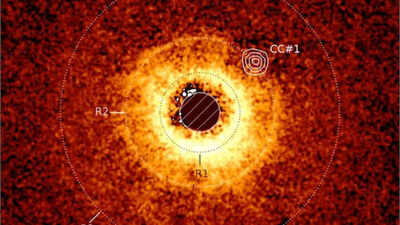The James Webb Space Telescope has achieved a significant milestone, directly imaging its first new planet after dedicating three years to the study of known exoplanets. This newly discovered world, designated TWA 7b, is a young planet that stands out as the lowest-mass planet ever directly imaged outside our solar system.

An artist's rendition depicts the James Webb Space Telescope's groundbreaking discovery of TWA 7b.
TWA 7b's mass is estimated to be approximately 0.3 times that of Jupiter, or about 100 times the mass of Earth. This makes it ten times lighter than any exoplanet previously directly imaged.
The exoplanet, TWA 7b, orbits a young, low-mass star named CE Antliae (or TWA 7). This star resides approximately 111 light-years away in the constellation Antlia. Discovered in 1999, CE Antliae is a member of the TW Hydrae Association, a group of exceptionally young stars. Estimated to be only 6.4 million years old, CE Antliae is a cosmic infant compared to our Sun, which is 4.6 billion years old. Its youth, combined with its nearly pole-on orientation as observed from Earth, made it an ideal target for JWST imaging.
Infrared imaging was crucial to the discovery of TWA 7b. Young, low-mass planets like TWA 7b emit thermal radiation in the infrared spectrum, a specialty of JWST. The telescope's Mid-Infrared Instrument (MIRI), equipped with a coronagraph, played a key role in the discovery.
A coronagraph works by blocking the overwhelming light of a star, allowing astronomers to detect faint nearby objects, such as exoplanets. Utilizing high-contrast imaging techniques, the JWST team identified a faint infrared source embedded within the debris disc surrounding TWA 7.
This faint source was found within a gap between rings of dust. Scientists believe that a planet's gravitational influence carves out such areas. Simulations confirmed that the presence of a planet with a mass similar to Saturn, located in that precise location, could explain the observed structure.
The disc surrounding TWA 7 isn't just a random cloud of debris; it comprises three distinct rings separated by gaps. One of these gaps features a narrow ring flanked by two dust-free regions, a telltale sign of the gravitational forces exerted by an orbiting planet. The infrared glow detected by JWST aligns perfectly with this ring gap, and its brightness, temperature (around 320 Kelvin or 47°C), and orbital distance (approximately 50 astronomical units from the star) all correspond to what scientists expected from a planet in this region.
The discovery of TWA 7b is a milestone in exoplanet science for several compelling reasons:
Astronomers propose that the structures observed in debris discs around young stars serve as blueprints for planetary formation. These rings and gaps represent zones where material either accumulates to form planets or is cleared out by their gravitational pull. TWA 7b may be the first direct observation of this process in action.
Researchers employed advanced image subtraction methods to detect TWA 7b. By removing residual starlight, they were able to isolate the planet from other celestial objects and background galaxies. This discovery highlights how new observing methods and instruments on JWST, such as the coronagraph and MIRI, are expanding our ability to discover previously inaccessible exoplanets. Thanks to JWST's mid-infrared sensitivity, it can now detect planets as massive and as cold as Saturn, a significant advancement in direct imaging capabilities.
JWST's ability to suppress starlight and detect faint heat signatures from small, cold planets is opening a new chapter in exoplanet discovery. Astronomers are optimistic that even lighter planets, potentially Neptune-mass or even super-Earths, could soon be within our reach.
Future follow-up observations will aim to:
Newer articles
 Esha Gupta Sets Record Straight: Actress Addresses Hardik Pandya Dating Rumors
Esha Gupta Sets Record Straight: Actress Addresses Hardik Pandya Dating Rumors
 Google Maps to Boost Navigation Accuracy with Fused Orientation Provider API
Google Maps to Boost Navigation Accuracy with Fused Orientation Provider API
 Global Vaccination Rates Plunge: Millions of Children Now Vulnerable to Preventable Diseases
Global Vaccination Rates Plunge: Millions of Children Now Vulnerable to Preventable Diseases
 Rishabh Pant: Greg Chappell Hails India Star as Cricket Revolutionary
Rishabh Pant: Greg Chappell Hails India Star as Cricket Revolutionary
 Skin Cancer Alert: How to Identify Suspicious Moles and Early Warning Signs
Skin Cancer Alert: How to Identify Suspicious Moles and Early Warning Signs
 Gavaskar Calls for Kuldeep Yadav's Inclusion in Second Test Amid Bumrah Fitness Concerns
Gavaskar Calls for Kuldeep Yadav's Inclusion in Second Test Amid Bumrah Fitness Concerns
 Is Daily Pooping a Must? Understanding Bowel Regularity and When to Worry
Is Daily Pooping a Must? Understanding Bowel Regularity and When to Worry
 Suryakumar Yadav's Sports Hernia: Understanding the Injury, Recovery, and Risk Factors for Athletes
Suryakumar Yadav's Sports Hernia: Understanding the Injury, Recovery, and Risk Factors for Athletes
 Vijay Sethupathi Apologizes Amid Controversy Over Son Surya's Debut Film 'Phoenix' and Alleged Video Removal Pressure
Vijay Sethupathi Apologizes Amid Controversy Over Son Surya's Debut Film 'Phoenix' and Alleged Video Removal Pressure
 Install Baccarat Hack Tool: The Secret to Winning
Install Baccarat Hack Tool: The Secret to Winning